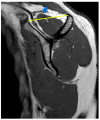Massive Irreparable Rotator Cuff Tears: Which Patients Will Benefit from Physiotherapy Exercise Programs? A Narrative Review
- PMID: 37047860
- PMCID: PMC10094518
- DOI: 10.3390/ijerph20075242
Massive Irreparable Rotator Cuff Tears: Which Patients Will Benefit from Physiotherapy Exercise Programs? A Narrative Review
Abstract
Massive irreparable rotator cuff tears can cause significant shoulder pain, disability and reduction in quality of life. Treatment approaches can be operative or non-operative. Operative approaches include reverse total shoulder arthroplasty, arthroscopic debridement, partial rotator cuff repair, subacromial balloon spacers, superior capsule reconstruction, and tendon transfer procedures. Non-operative approaches include physiotherapy exercise programs and corticosteroid injections. There are no randomized controlled trials comparing the different treatment approaches. It is therefore challenging for clinicians to advise patients on what is their best treatment pathway. Physiotherapy exercise programs are less expensive and have lower risks for patients than surgical approaches. However, the success of physiotherapy in patients with massive irreparable rotator cuff tears is highly variable with published success rates of 32-96%. Several cohort studies have sought to identify if certain factors are predictive of success with physiotherapy. Several biomechanical factors were identified as possibly being related to a successful or unsuccessful outcome following physiotherapy, with complete tear of subscapularis demonstrating the strongest evidence. However, there were no appropriately designed prognostic studies. There has been a strong emphasis on biomechanical factors. Other domains such as psychosocial factors, which are important in similar patient populations, have not been explored. We recommend that further research is needed in this area and should include randomized controlled trials comparing treatment approaches and longitudinal prospective prognostic studies to identify predictors of treatment success.
Keywords: conservative treatment; irreparable; massive; non-operative; physiotherapy; prognosis; prognostic; rehabilitation; review; rotator cuff.
Conflict of interest statement
A.L. is a paid consultant for Arthrex, Stryker and Medacta. He received royalties from Stryker. He is the founder of FORE, Med4Cast and BeeMed. The funders had no role in the design of the study; in the collection, analyses, or interpretation of data; in the writing of the manuscript; or in the decision to publish the results.
Figures

 indicates level of supraspinatus tendon retraction.
indicates level of supraspinatus tendon retraction.


 indicates supraspinatus extending above the tangent.
indicates supraspinatus extending above the tangent.References
Publication types
MeSH terms
LinkOut - more resources
Full Text Sources
Medical

